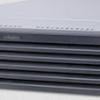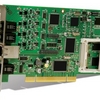PIKA Technologies today released major hardware and software enhancements to their host-based media processing platform. Two new PCIe boards are added to their hardware portfolio and support was added for high-volume fax and advanced conferencing. PIKA boards can run on Asterisk, so fans of PIKA hardware that happen to also like Asterisk will welcome this bit of news. Asterisk has never been known to do well with faxing. I wonder if PIKA's high-volume fax hardware will improve that?
Anyway, here's the announcement:
Ottawa, ON, Canada - June 27, 2007 - PIKA Technologies, a designer and manufacturer of plug-in media-processing hardware and software, today announced that it has further strengthened its product portfolio by releasing two new network interface boards and added major features including fax and advanced conferencing capabilities to its host-based processing platform.
"PIKA continues to support its customers with the solutions they need to develop their applications using host-based media processing rather than the traditional, more expensive DSP-based media processing," said Terry Atwood, vice president, sales, marketing and customer care at PIKA. "By enabling developers to integrate fax and advanced conferencing into their applications and to connect their applications to digital and analog trunks and stations, PIKA is helping the market move to a more affordable, software-based media-processing landscape, without sacrificing functionality or robustness."
The hardware additions to PIKA's platform include a PCI express (PCIe) version of the Digital T1/E1 Gateway trunk board, and a PCIe Analog Station (FXS) board, from PIKA's Daytona analog family.
These two boards complete the full range of analog and T1/E1 hardware-based gateway products that PIKA has developed to increase the robustness and appeal of its AllOnHost software. The future of voice is recognized to be in IP, but the transition will not be immediate for most organizations. The PIKA hardware enables developers to design IP-centric applications that support the shift to IP but allow for a gradual migration that will incorporate a mix of new VoIP and existing TDM technologies.
"Our research indicates that in spite of over 70% of telephony lines shipped today being converged, the number of actual lines connecting to IP endpoints is considerably lower," said Krithi Rao, Industry Analyst - Enterprise Communications, ICT, Frost & Sullivan. "Many are next generation, hybrid systems that can support IP and TDM and pure IP systems. Further, the relative penetration of IP into the installed base is less than 20%. A large percentage of enterprise IP deployments connect to an analog or digital network and to analog and digital phones and is therefore driving TDM interface card deployments."
In addition to the expansion of its hardware portfolio, PIKA has released version 2.2 of its host-based media processing software, providing fax and advanced conference capabilities to developers.
Customers transitioning from DSP-based to host-based media processing have remarked about the high level of support received from PIKA, not only from a customer service standpoint, but also from the product development side.
"Our eurovoice objects application development environment has been based on PIKA's proven, reliable DSP hardware for many years," said Martin Steer, managing director, eurovoice limited. "In 2006, when PIKA released its initial host-based offering, we immediately designed it in. Since then, PIKA has consistently enhanced the density and robustness, as well as the feature content of their software. This release is another example of PIKA's commitment to meeting our requirements and helping us to meet the requirements of our customers."
Hardware
PIKA's PCI express (PCIe) version of the Digital T1/E1 Gateway trunk board, along with the PCI version, which was introduced last year, are both members of PIKA's PrimeNet digital family. These boards support up to four T1 or E1 spans, configurable in single span increments. They provide 24-120 ports of TDM digital network connectivity for applications such as IVR/self service, IP-PBX, fax broadcast and call center systems.
The PCIe Analog Station (FXS) board, a member of PIKA's Daytona analog family, has also been added to the product portfolio. Supporting the connection of up to 12 ports for traditional analog telephone devices, the board is designed to meet the analog telephone requirements of IP-PBXs and call center systems. An advantage over other competitive offerings, this new board derives its required power from the PC/server backplane, requiring no external power supply.
Both new interface boards conform to the 9.5-inch PCIe form factor, enabling them to be used in off-the-shelf industry standard chassis and PCs, which is vital as PC manufacturers decrease the number of PCI slots and increase the number of PCIe slots in their standard offerings.
A step ahead of most competitive solutions on the market today, PIKA's entire portfolio of host-based media compatible hardware is software expandable in the field. For example, a digital trunk board initially purchased and installed with a single span software license can be quickly and easily upgraded, in place, to a dual, triple or quad span. Typically, this upgrade would require an expensive trip to the site to open the chassis, remove the existing board and replace it with a new board.
Software
Version 2.2 of PIKA's host-based media processing software particularly benefits application developers who create large, single purpose broadcast fax systems, as well as those who need to fax-enable their existing IVR, self-service, messaging or IP-PBX application. PIKA provides 25% of the port capacity of the hardware as fax ports, at no additional charge. For example, a single span T1 board comes equipped with 6 free fax ports. PIKA's unique resource sharing architecture is ideal to support a large variety of fax applications.
IP-PBX and conferencing system developers will benefit from enhancements to the conferencing capabilities added in version 2.2. Features such as gain pad, summing, switching and DTMF clamping, previously only available in DSP-based architectures, are now available in PIKA's host-based environment as well.
android apple asterisk at&t blackberry cell phone cisco dell digium e911 facebook fcc google google talk gps im ip-pbx ipad iphone ipod itexpo ITEXPO lync microsoft mobile phone open source outage phone review sip skype sony unified communications verizon video video conferencing voip vonage wireless xbox 360
- Apple (280)
- Bittorrent (2)
- Call Center and CRM (48)
- Computer Hardware (183)
- Computer Software (71)
- Gadgets (650)
- Google (225)
- Home Entertainment (263)
- Internet (173)
- Linux (111)
- Microsoft (376)
- MovableType (48)
- News (187)
- Personal and Humor (118)
- Politics (9)
- Reviews (246)
- Security (2)
- Social Networking (42)
- Sports/Outdoor Technology (9)
- Tablets (32)
- Technology and Science (355)
- Unified Communications (471)
- VoIP (2285)
- Wireless (584)
- p2p (20)
- March 2014
- February 2014
- January 2014
- December 2013
- November 2013
- October 2013
- September 2013
- August 2013
- July 2013
- June 2013
- May 2013
- April 2013
- March 2013
- February 2013
- January 2013
- December 2012
- November 2012
- October 2012
- September 2012
- August 2012
- July 2012
- June 2012
- May 2012
- April 2012
- March 2012
- February 2012
- January 2012
- December 2011
- November 2011
- October 2011
- September 2011
- August 2011
- July 2011
- June 2011
- May 2011
- April 2011
- March 2011
- February 2011
- January 2011
- December 2010
- November 2010
- October 2010
- September 2010
- August 2010
- July 2010
- June 2010
- May 2010
- April 2010
- March 2010
- February 2010
- January 2010
- December 2009
- November 2009
- October 2009
- September 2009
- August 2009
- July 2009
- June 2009
- May 2009
- April 2009
- March 2009
- February 2009
- January 2009
- December 2008
- November 2008
- October 2008
- September 2008
- August 2008
- July 2008
- June 2008
- May 2008
- April 2008
- March 2008
- February 2008
- January 2008
- December 2007
- November 2007
- October 2007
- September 2007
- August 2007
- July 2007
- June 2007
- May 2007
- April 2007
- March 2007
- February 2007
- January 2007
- December 2006
- November 2006
- October 2006
- September 2006
- August 2006
- July 2006
- June 2006
- May 2006
- April 2006
- March 2006
- February 2006
- January 2006
- December 2005
- November 2005
- October 2005
- September 2005
- August 2005
- July 2005
- June 2005
- May 2005
- April 2005
- March 2005
- February 2005
- January 2005
- December 2004
- November 2004
- October 2004
- September 2004
- August 2004
- July 2004
- June 2004
- May 2004
- April 2004
- March 2004
Featured Videos












